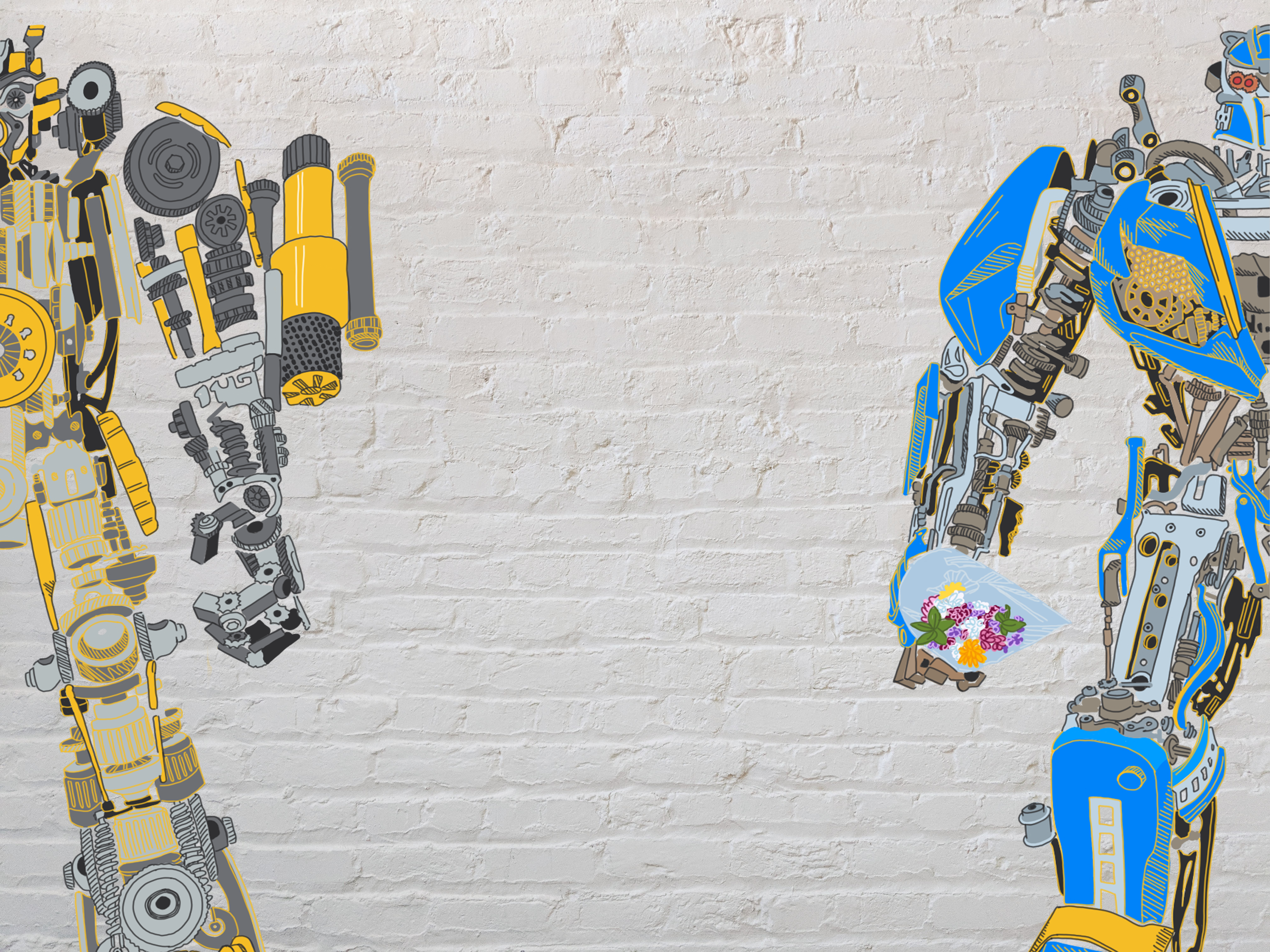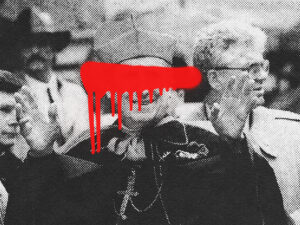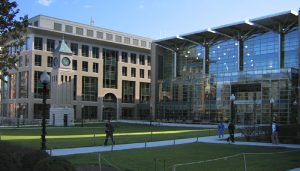The towering Transformers sculptures on Prospect Street, NW, are facing an old foe from 2021—a three-person federal board determined to get rid of them. The Old Georgetown Board voted (again) on April 6 to remove the Transformers after having granted them a six-month reprieve due to public interest, citing them as incompatible with Georgetown’s historic character.
The decision has been wildly unpopular with Georgetown students and community members, many of whom have offered an outpouring of support in the form of flowers and letters left in front of the sculptures, as well as a fast-growing petition.
Jordynn Jenkins (CAS ’24) started the “Keep the Transformers Sculptures!” Change.org petition on April 7, which has garnered over 500 signatures as of April 26.
“To be honest, I kind of started the petition as a joke and then once I saw, just even the comments of people saying how much joy the Transformers bring them, I realized how big of an issue it really was,” Jenkins told the Voice. “I really didn’t expect this many signatures.”
Georgetown professor and neuroscientist Dr. Newton Howard, the owner and commissioner of the sculptures, is pursuing legal action and has hired a lawyer to protect Bumblebee and Optimus Prime.
He placed the 2-ton, 6- and 10-foot tall Transformers outside his home around two years ago. The steel sculptures made of hundreds of car parts were originally inspired by Howard’s work with a range of neurological disorders and technology.
“I work in a lot of robotics, and brain implants, and ways to help people with Parkinson’s, and things like that. So, a lot of my decoration inside the house is made of robots and Transformers,” Howard said. “And when children come around to visit, they seem to like them and be drawn to them. And I said to myself, ‘Why don’t I take some of them and put them outside?’”
Despite the overwhelming community support and appreciation for the sculptures, some disgruntled neighbors view the sculptures as a nuisance and a magnet for unwanted crowds and tourists. Howard expressed his frustration with these objections, which seem to have taken priority over the feelings of the rest of the community.
“Our basic core values should be about welcoming people, not rejecting neighbors, visitors from outside of town and from outside of our neighborhoods. And we don’t want to show we don’t want them around and they’re really disturbing us,” Howard said. “It’s alarming that I live next to neighbors who think that way.”
The Transformers first faced opposition two years ago from the Old Georgetown Board, a federal board led by a three-person panel of architects. According to their website records, the board primarily reviews concepts and permits for buildings, additions, or renovations to determine if they preserve and protect the purported historical character of the District.
In 2021, the board reviewed the sculptures after they were installed without a permit and found the Transformers to violate their criteria, according to a statement from the secretary of the U.S. Commission of Fine Arts, Thomas Luebke.
“In terms of guidelines, the Old Georgetown Act is extremely vague, and it describes the purpose for the review as being authorized ‘in order to promote the general welfare and to preserve and protect the places and areas of historic interest, exterior architectural features, and examples of the type of architecture used in the National Capital in its initial years,’” Luebke wrote.
But to Howard, these guidelines are insufficient to merit the Transformers’ removal. “[The Old Georgetown Board] doesn’t have any guidelines or anything published or otherwise available,” Howard said. “To me it’s just an opinion of a group of people that don’t even know what the heck they are managing.”
Jenkins expressed that the overwhelming community support for the statues she’s seen through the petition alone should play a greater role in deciding the Transformers’ fate.
“I think it’s pretty unfair that three people kind of get to have a say when obviously there’s hundreds of people who are in support of the Transformers,” Jenkins said. “So hopefully they’ll just be more willing to listen to people in the neighborhood who are saying like, ‘We actually really do love these and we would hate to see them taken down.’”
To Jenkins, the sculptures bring the neighborhood an element of originality that should be encouraged instead of blocked.
“This is a really traditional, historic kind of neighborhood. But I think when someone comes in and wants to bring that diversity, that different sort of art, I think that’s something that should be welcomed, especially if they’re doing it in a way that is safe and that’s not dangerous or risky to anybody else,” she said.
The sculptures represent a piece of art that inspires joy in Georgetown, as commenters on the petition noted. They’ve strongly defended the sculptures against claims that they should be removed for not aligning with Georgetown’s traditional landscape. “The sculptures bring joy to almost all who pass by. If these sculptures are not compatible with Old Georgetown historic district, then the District should also ban cars, which are equally ahistorical,” one supporter wrote.
When this article appears in print on campus, the fate of the Transformers will have been decided. According to Luebke, the proposal for the Transformers is under review by the D.C. Department of Transportation’s Public Space Committee, which will make the final decision on the Transformers’ future at a hearing on April 27.
Howard said that regardless of the sculptures’ future, the outpouring of generosity and support he’s seen since the vote shows that the values that inspired them persist in the community.
“I step outside and I found flowers, and comments and letters and all kinds of wonderful things that [show], you know, that our core values are intact,” Howard said. “All that makes it worthwhile.”






So all the old people who aren’t going to be around for much longer want to keep the town the way it is, but the young people who are going to inherit the town and continue to live there after the old people are long dead want to keep them? There’s really only one logical response, embrace the future. The small towns always want to attract tourists for income, but now they have a tourist attraction and they want to get rid of it? What are they planned to do attract people with crotchety old dinosaurs?